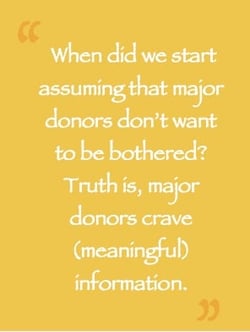Why are so many nonprofits falling short in raising major gifts? This is number four in a five-part series exploring five reasons why. In our first post we talked about how talent gaps on the fundraising team is the biggest factor. The next two we discussed were how too many organizations are failing to ask, and have a paucity of offers that are compelling and appropriate for major donors. In the final two entries we will discuss the importance of making good use of the “space between” solicitations to keep your donors in the fold…
Reason #4: NOT MAKING GOOD USE OF THE “SPACE BETWEEN” SOLICITATIONS
According to the National Center for Charitable Statistics, there are now more than 1.5 million nonprofits registered in the United States, a 25 percent increase from ten years ago. In annual surveys, the vast majority of nonprofits report increases in demand for their services. Yet according to a recent article by the Chronicle of Philanthropy, charitable giving as a percent of GDP—arguably the best way to measure real growth in giving—has been stuck at 2% for more than four decades. One California-based funder sums it up this way: “In the past few years alone, requests for funding have more than doubled while dollars available have hardly increased.” Yes, asking is important, but when raising major gifts in this hyper-competitive environment, how you engage donors in the “space between” solicitations is also critical.
 At many (if not most) organizations we’ve worked with, when someone makes a first major gift, two things will happen almost automatically: 1) the donor is suppressed from the mass market mailings and communications, and 2) the donor is assigned to a major gift officer’s portfolio. While this shift to “personal handling” may seem to make sense on the surface, based on our analyses of the giving patterns of thousands of major donors at dozens of organizations, we have found this actually has the opposite intended effect—in many cases it crushes future giving. In essence you are cutting your top partners off from regular communications. When did we start assuming that major donors don’t want to be “bothered,” and that it was smart to limit our contact with them? Truth is, major donors crave (meaningful) information.
At many (if not most) organizations we’ve worked with, when someone makes a first major gift, two things will happen almost automatically: 1) the donor is suppressed from the mass market mailings and communications, and 2) the donor is assigned to a major gift officer’s portfolio. While this shift to “personal handling” may seem to make sense on the surface, based on our analyses of the giving patterns of thousands of major donors at dozens of organizations, we have found this actually has the opposite intended effect—in many cases it crushes future giving. In essence you are cutting your top partners off from regular communications. When did we start assuming that major donors don’t want to be “bothered,” and that it was smart to limit our contact with them? Truth is, major donors crave (meaningful) information.
Think about it: As your largest investors, major donors are more interested than anyone else in learning how their gifts are making a difference in people’s lives. If you want to do a better job keeping major donors and lifting them up to higher levels of giving, you need to immerse them in a stream of impactful communications that continually connects them to the impact that their investment has on the lives of people. This should be decidedly different from what you are sending everyone else. You don’t need to spend a lot of money on it, since we aren’t talking about huge volumes and major donors prefer things that are personally created rather than mass-produced. And remember that today’s donors are adept at filtering information from multiple sources—don’t rely too much on mail. Use every channel at your disposal, especially electronic formats that they can share on social media with others in their circles of influence.
Click this link to continue reading the final entry of this series…


